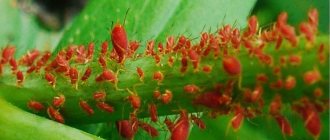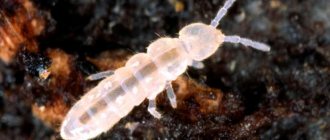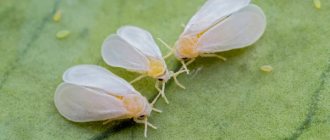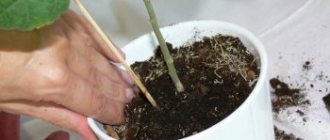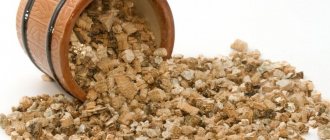Podury: photo
Fools: photo.
Prevention
As practice shows, it is easier to prevent plants from becoming infected with podura than to treat them later. Preventive measures:
- It is better to purchase plants only in specialized stores, where sellers can provide all the necessary documentation and quality certificates.
- It is important to provide a high-quality drainage layer to prevent excessive moisture accumulation.
- Select the right planting material.
- Provide proper care for the plant, taking into account all its individual needs.
- Systematically conduct an external inspection of plants (experienced gardeners recommend doing this at least once every two weeks).
- If you notice an affected plant, it must be immediately isolated from the rest to prevent the spread of pests.
Springtails will never grow in a room where cleaning is done regularly and there is no mold.
3.7/5 — (3 votes)
Description of the pest
Name: Real fools Lat.:
PoduridaeClass: Springtails - Collembola Order: Springtails - Poduromorpha
| Habitats: | indoor plants, garden and vegetable garden |
| Dangerous for: | colors |
| Means of destruction: | Fufanol, chemicals, decoctions |
Podura: photo.
Poduras are similar to small caterpillars. Color white or cream. Very rarely they are greenish or silvery. Body length is about 2 mm. Sometimes the length reaches 1 cm. The body has an oval shape.
Thanks to a special fork, they jump perfectly, pushing off with its help. This is what distinguishes the insect from the mealybug. When at rest, the organ is hidden under the abdomen.
The eggs are round in shape. The color is greenish-yellow with shine. After laying, larvae identical to adult individuals appear within 18–20 days. The larvae pose the same danger to flowers as the adults.
Very often, fools are confused with springtails, which live in indoor plants. In order not to be confused, we will continue to consider insects and pests of indoor plants.
Mechanical methods of struggle
Poor quality care, accumulations of dried leaves and excess moisture create ideal conditions for the growth of houseplants. Therefore, to eliminate pests, it is necessary, first of all, to regulate watering, which is the main cause of increased soil moisture. Deprived of their usual and comfortable living conditions, springtails will no longer disturb the plant.
There are other ways to get rid of the fool:
- It is very important to comply with indoor humidity levels. To do this, you should ventilate the room more often, dry clothes outside, and provide access to sunlight. A special device that absorbs excess moisture will help regulate the humidity level.
- Sprinkling the soil with ash or sand is one of the most effective methods of killing podura. It can be used for almost all plantings. The exception is plants growing in acidic soil. These include camellia, gardenia or azalea.
Camellia, gardenia and azalea - To get rid of pests, just place the pot with the plant in water. After that, all that remains to do on its surface is to collect the floating springtails.
- Particular attention should be paid to the drainage system. After all, it is the clogging of the holes at the bottom of the flowerpot that causes water to stagnate. A few pebbles, which are placed at the bottom of the pot when replanting the flower, will help to avoid this.
- Replacing the substrate is another effective method to get rid of springtails. It is important not only to remove the contaminated soil, but also to thoroughly rinse the root system.
- You should also not use organic fertilizers too often. Residues from tea leaves or ground coffee can cause the development of mold or mildew, so they are added to the soil no more than once a week. After 2-3 days, the organic particles are removed and the substrate is carefully loosened so that the soil is enriched with oxygen. It is important to eliminate all factors that contribute to soil decay and mold.
- There is another original folk method of getting rid of the fungus, which is safe both for the plant and for the person himself. To do this, you will need a raw potato, which is cut into two parts, each of which is placed cut side down on the substrate. If you lift these halves after a few hours, you will see a lot of pests on them. After which the bait should be shaken off or washed off with water and the “bait” should be installed again.
Common types
The parasite population depends on the humidity level. High humidity promotes active reproduction. Among the most common varieties, it is worth highlighting several main ones.
White . Living in the upper layer of the earth. Favorite places are greenhouses and greenhouses.
Vegetable . Eats ornamental crops and garden plants.
Mushroom . It feeds on young vegetative organs of plants and seedlings.
Preventive actions
Podura may appear in orchids, violets, and other plants. To prevent this from happening, it is better to remember about prevention in advance. First of all, we are talking about proper agricultural technology. The soil should not contain many components that actively decompose (tea brewing, discarded leaves and others).
It is also imperative to avoid overwatering the plant. If there is a lot of moisture, it is recommended to additionally sprinkle the soil with dry sand. This will not allow the fools to actively reproduce in an environment favorable to them. You need to choose pots according to the size of the plants so that the roots occupy all the free space. Podura on orchids or other flowers can appear even with proper care and prevention. In such a situation, you need to know how to deal with the parasite.
Reasons for the appearance of dupes
A small number of insects are always present in the soil of indoor plants, greenhouses, and especially open areas. They cause harm in large numbers. The appearance of parasites on ornamental plants is associated with:
- high humidity due to disruption of the irrigation system - watering should not be abused;
- increased level of moisture in the room - a damp microclimate contributes to the invasion of insects;
- the development of putrefactive processes - this refers to black tea leaves that rot, and to stagnation of moisture. They need to be removed;
- non-compliance with certain temperatures;
- weakened immune system in a calm state;
- the presence of moss in the container;
- violation of care - fallen leaves rot and attract fungi and parasites.
Damage caused
Single damage caused by a few podurs cannot cause much harm to the plant. Large poduras (1-1.5 mm) can only cause real and significant damage to Saintpaulia seedlings. The seedlings at the stage of opening the cotyledon leaves are completely eaten by springtails.
The harm from poduras is also significant in cases where there are too many of them and the room temperature is low. Plants weakened by unfavorable conditions slow down their growth and development and cannot regenerate normally. Multiple damages caused by podura under such conditions become an open gate for a wide variety of fungal and bacterial infections, which can not only weaken, but also destroy part of the plants in your collection.
Photo 4. Saintpaulia seedling eaten by podura.
Some useful tips
It is better to water when the soil is moist so as not to burn the roots, and you should also fertilize when the soil is damp... Remember that you should only use sterilized soil, and purchase plants in a safe place! , Soil. If there is a need to replant or sow something, it is better to “do it in bulk: buy soil, immediately put this package in the bathroom at home, add baking powder to the soil. There, carefully place the substrate into glass containers (for use in the microwave) and cover them with lids. Carefully roll up the bag from under the soil and throw it away, it’s better to take it out of the house right away (you never know what’s in there). Then all the containers, along with the bath, under a hot shower. Containers take turns to be steamed in the microwave (each, 2 times for 10 minutes). That's it, the soil is ready for planting. , Moss. If you need to add moss to the soil (for example, for Saintpaulias), then first you need to pour boiling water over the moss (so that if any of the insects were there, they would cook). Squeeze out the moss and dry. Only dry moss should be added to pots with violets, not fresh, otherwise it will quickly disappear there. , Cora. Boil the tree bark in water for 30-40 minutes, and then steam it in the microwave. , “Alien” insects
If you bring a new plant into your home from the store (or anywhere else, it doesn’t matter), then don’t put it on your bedside tables, tables or shelves, don’t lean it against the walls, and don’t try it on in a new place. Take the newcomer straight into the bath and do the “etching” there.
, The area with the diseased plant must be disinfected. Every nook and cranny, every joint and every crevice of the window sill and window must be very carefully sprayed with alcohol (one might say, pour it in). If the flowers were on shelves or stands, then the whole thing is also sprayed with alcohol (do not underestimate the enemy!), and this procedure should be repeated the next day, just in case. In the hot period, 8 days after the first treatment of flowers, you need to carry out a second one; in the cool period, you can increase this gap by 2 days. Everything is repeated: table, actellik, packages. You can spray all the cracks with alcohol again to be sure. And the last (third) etching is done again after 8-10 days. After this, the permanent locations of the flowers are again sprayed with alcohol.
Why do colonies of springtails attack indoor plants?
When watering, you can notice accumulations of collembola bodies on the surface of the soil and unabsorbed water.
They are tiny in size (0.25–6 mm), elongated or round in shape, and have 6 legs. Poduras are wingless creatures of gray, white, brown color that slowly crawl along the substrate and jump short distances. Springtails belong to the subclass Collembola. Representatives of this group of insects develop in the soil and feed on dead plant organs, fungi, algae, and bacteria. Springtails are capable of changing their diet and damaging tender parts of plants. They do not attack humans or animals.
In moist soils with a high organic content, at favorable temperatures, springtails multiply quickly. As soon as the earthen ball dries out, the body of the collembola begins to lose moisture. The entire colony goes in search of a wetter substrate.
Poduras enter the house from the street if the lawn or flower bed is dry. They penetrate through ventilation holes, cesspools, and any sources of moisture around the premises. In rooms where it is damp, they can even be found in furniture. As soon as the pockets of mold and moisture disappear, the springtails die or go in search of favorable places.
Destruction of midges using chemicals
Important! Chemical compositions, as the most radical methods of exterminating “midges,” can be resorted to, but in the most extreme cases. . If necessary, the earth mixture is spilled with a solution of a pesticide or added to its top layer
For treatment, you should choose low-toxic drugs, such as “Mukhoed”, “Grom-2”, “Fufanon”, “Agravertin”, “Fitoverm”, “Aktara”, “Inta-vir”. They are characterized by a wide spectrum of action and relative safety.
If necessary, the earth mixture is spilled with a solution of a toxic chemical or added to its top layer. For treatment, you should choose low-toxic drugs, such as “Mukhoed”, “Grom-2”, “Fufanon”, “Agravertin”, “Fitoverm”, “Aktara”, “Inta-vir”. They are characterized by a wide spectrum of action and relative safety.
The Actellik insecticide is highly toxic and volatile, so it is not approved for use at home.
The special Bona Forte spray against flying arthropods will help in combating pests. It is a contact insecticide that paralyzes insects. The active substance in its composition is harmless to humans and domestic animals, quickly decomposes into safe products and does not cause addiction in midges.
To prevent infection by soil mosquitoes, use the “Green Shield” drug, which contains essential oils to repel pests and mineral salts to nourish plants and increase their immunity.
There is also the cheapest and easiest way to exterminate midges - this is to replace the soil mixture and treat the surface of the soil, tray, bottom of the pot, window sills, shelves and walls near the houseplant with ordinary dichlorvos. As a result, both adult flying insects and their larvae will be destroyed.
Dichlorvos still remains, although toxic, the most effective remedy
When working with pesticides, safety precautions must be observed:
- In the warm season, carry out chemical treatment in the fresh air, in the cold season with the window open.
- To avoid chemical burns, allow treated plants to dry before exposing them to direct sunlight.
- Protect the respiratory organs with a respirator or gauze bandage.
- Carry out the treatment in a robe.
- At the end of the procedure, wash your hands and face with soap.
- Store toxic solutions out of the reach of children.
Benefits and harms
It's time to present the arguments for and against springtails. There is something in us humans that makes us attack and kill even the most harmless creatures just because we don’t like their appearance, or accidentally crossed our path. All of the above also applies to springtails - these are completely harmless creatures.
However, there is a problem, and it needs to be solved, so first we will describe the negative side of this insect.
Harm
What forces us to fight collembola is not the threat of being bitten or the threat to our food supplies. No, this is ordinary disgust, which can lead some people to panic.
Of course, it’s unpleasant if you find a herd of springtails in your apartment. Instead of just collecting them and throwing them out into the street, we will begin to fight them.
Naturally, the most favorite places in our home for springtails are damp rooms: the corners of the kitchen under the sink, the corners under the plumbing fixtures in the bathroom. Particular accumulations are observed in areas of leakage. There, under constant drops of water, mold forms - the favorite food of fools.
The appearance of springtails in a sparkling clean bathroom is perceived by people as something terrible, and the hand itself reaches for a bottle of Dichlorvos or another similar product.
The second case of sabotage can be observed on indoor plants. Here, springtails can crawl along the soil in a pot, and especially impudent individuals can even try to gnaw on the leaves. Of course, here too it is necessary to take measures for destruction.
Benefit
Before we start fighting collembola, even in a separate article, we’ll tell you about the benefits these amazing creatures bring. Here we can observe two sides of the insect's usefulness.
Firstly, by eating tons of dead organic matter, springtails transform it into exactly that substance that all gardeners adore - humus. The feces of these insects are almost ready-made food for microorganisms, and the products of subsequent decay are already absorbed by our plants. Therefore, the more different small creatures in your garden bed, we mean not only springtails, the faster the dead organic matter will work to increase soil fertility.
The second benefit of springtails is their use as food for aquarium fish, reptiles or amphibians. Special websites for lovers of exotic fish even describe methods of breeding springtails, as they say, “for livestock feed.” They advise feeding them potato peelings.
How to get rid of springtails in the bathroom
To destroy pests, they need to be deprived of a comfortable habitat. To do this, first of all, reduce the air humidity. Ventilate the bathroom more often; installing a heated towel rail will help in winter. It will dry the air and prevent condensation from forming on the walls. Eliminate all leaks and treat joints with sealant.
Be sure to remove all mold and clean the walls thoroughly. You can treat them with special insecticidal aerosols (Clean House, Raptor) or wash them with water and vinegar or soap.

